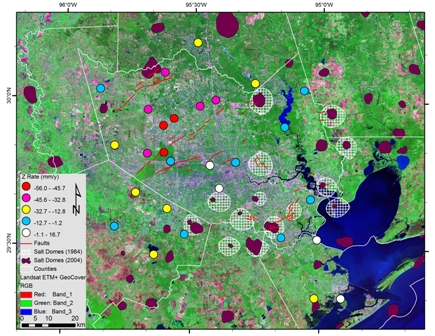Some points in Jersey Village are subsiding by up to 5.5 centimeters (about 2 inches) a year, said Shuhab Khan, an associate professor of geology at UH. Khan, along with UH geology professor Kevin Burke and former Ph.D. student and UH alumnus Richard Engelkemeir, studied a decade’s worth of detailed GPS data measuring the elevation of various points throughout the Houston area. They recently published their findings in the journal Tectonophysics, an international medium for the publication of research in the fields of geotectonics, geology and physics of the Earth’s crust and interior.
“A sprawling area of northwestern Harris County is gradually subsiding, but the points in Jersey Village are sinking fastest,” Khan said. “The area is roughly 30 kilometers by 30 kilometers, which is the equivalent of about 18 miles by 18 miles.”
 The raw data was obtained from the Houston-Galveston Coastal Subsidence District.
Khan’s study processed and analyzed GPS data from more than two dozen measurement
points throughout the county, covering 1995 to 2005. Extrapolating data from six measurement
stations, Khan roughly marks the boundaries of the vast subsiding area. At three of
those measurement spots, centered around Jersey Village, the sinking was particularly
fast.
The raw data was obtained from the Houston-Galveston Coastal Subsidence District.
Khan’s study processed and analyzed GPS data from more than two dozen measurement
points throughout the county, covering 1995 to 2005. Extrapolating data from six measurement
stations, Khan roughly marks the boundaries of the vast subsiding area. At three of
those measurement spots, centered around Jersey Village, the sinking was particularly
fast. “Because GPS can pinpoint location with millimeter precision, it is an excellent tool to measure even the most subtle changes over time in the ground,” Khan said. “The most likely reason for the sinking of Jersey Village is the withdrawal of water from deep beneath the surface. While groundwater withdrawal has ceased in most of the Houston area, it continues in the northwestern part of the county that has seen a rapid growth in population.”
The fate of the Brownwood neighborhood near Baytown illustrates the potential consequences of rapid subsidence, Khan said. When the residential subdivision was first developed in the 1930s, ground elevation was about 3 meters (nearly 10 feet) above sea level. Forty years later, the neighborhood stood just half a meter above sea level and was subject to frequent flooding. In 1983, Hurricane Alicia destroyed the subdivision, and the area became the Baytown Nature Center. The sinking of Brownwood was attributed to the massive groundwater withdrawal by the petrochemical plants along the Houston Ship Channel.
The research team hopes the new data that pinpoint precisely where and how quickly the ground is moving can aid the region’s builders and city planners to mitigate the damage caused by the ongoing subsidence northwest of Houston.
Khan’s analysis also showed some gradual rising southeast of Houston along the coast. The coastal area has several vast salt domes deep beneath the surface. Since salt has a lower density than common crustal rocks, it rises and pushes up the ground. He said that further study also might link salt dome activity along the coast to the surface movements occurring elsewhere in the region.
Khan’s previous work on the region’s elevation has already garnered widespread attention from local media, homeowners and builders. Geologists had long known about the existence of faults in southeast Texas, but Khan and Engelkemeir produced a comprehensive map in 2008 pinpointing the precise locations of some 300 faults traversing the Houston area.
The research team stressed these local fault lines are not the kinds that wreak havoc in earthquake-prone California, but they can move up to an inch per year. Such movement over several years can cause serious damage to buildings and streets that straddle a fault line.
For related research, visit http://www.uh.edu/news-events/pdf/2008%20faultline%20research%20PR.
About the University of Houston
The University of Houston is a comprehensive national research institution serving the globally competitive Houston and Gulf Coast Region by providing world-class faculty, experiential learning and strategic industry partnerships. UH serves more than 38,500 students in the nation’s fourth-largest city, located in the most ethnically and culturally diverse region of the country.
About the College of Natural Sciences and Mathematics
The UH College of Natural Sciences and Mathematics, with 181 ranked faculty and approximately 4,500 students, offers bachelor’s, master’s and doctoral degrees in the natural sciences, computational sciences and mathematics. Faculty members in the departments of biology and biochemistry, chemistry, computer science, earth and atmospheric sciences, mathematics and physics conduct internationally recognized research in collaboration with industry, Texas Medical Center institutions, NASA and others worldwide.
For more information about UH, visit the university’s Newsroom at http://www.uh.edu/news-events/.
To receive UH science news via e-mail, visit http://www.uh.edu/news-events/mailing-lists/sciencelistserv/index.php.
For additional news alerts about UH, follow us on Facebook and Twitter.